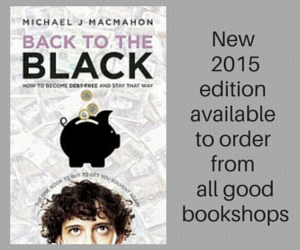 When I launched the second edition of my book Back to the Black … how to become debt-free and stay that way, we had a party. The subject of debt is serious, of course, so we felt a little frivolity would be good. The party – sorry, launch event – was chaired by my good friend, the author and journalist Debbie Young, and she came up with a great idea to get everyone involved.
When I launched the second edition of my book Back to the Black … how to become debt-free and stay that way, we had a party. The subject of debt is serious, of course, so we felt a little frivolity would be good. The party – sorry, launch event – was chaired by my good friend, the author and journalist Debbie Young, and she came up with a great idea to get everyone involved.
It seems that many of us save money by making small economies on necessities – ‘Scrooging’ – but then immediately blow much larger amounts on luxuries – ‘Splurging’.
So we invited our audience members to give examples of how they’d done exactly that. Nearly all of them were happy to accept the challenge.
THE CHALLENGE
Our question was this: “please share your best money-saving tip … and then confess your worst extravagance.”
Here are the answers we got:
- “Looking for the double-points deals at Tesco … but then using a store card (with an APR of over 30%) to buy clothes.”
- “Buying at charity shops or getting stuff from Freecycle … but then buying a piano when I didn’t have anywhere to put it.”
- “Buying most of our food (and all of our drink) at Aldi … but then buying a BMW for my business.”
- “Using a ‘My Waitrose’ loyalty card to claim a free coffee and newspaper if spending more than £10 at the weekend … but then spending far more than that £10 minimum.”
- “Going to the M&S bakery after 6pm to stock up on reduced bread and cakes to freeze for later … but then staying overnight at the Waldorf Astoria to attend a wedding, when I could have stayed at the Travelodge.”
- “Refusing to pay £1 for a bus-fare, even in the rain … but owning several pairs of shoes that cost more than £150 each.”
- “Calculating the total cost of credit before buying anything on a card … … but then buying a new motorbike.”
These were all good; but the winning entry on the night of the launch combined a Scrooge and a Splurge in one short and elegant phrase:
“Champagne with out-of-date food.”
We thought that deserved a prize.
THE BOOK LAUNCH
The launch event at which this fun idea was kicked around was for the second edition of Back to the Black. It was held at the Bristol branch of Foyles’ bookstore.
We offered a prize for the best Scrooge & Splurge idea. In keeping with the theme, it was a toy car … a Bentley, of course. Also in keeping, the drinks and nibbles were all sourced from the aforementioned Aldi. (For readers who are not UK-based, that’s a German-owned budget supermarket.)
THE MORAL OF THE STORY … AND A NEW BOOK
Scrooging and Splurging, even within minutes of each other, is very understandable. I do it myself. But I know that there would have been no point in extricating myself from a debt crisis (which I did in the late ‘90s, as I relate in Back to the Black) would have been pointless if I’d then got back into debt. So I have to be sure that my Scrooge incidents outnumber the Splurge incidents.
“Scrooging and Splurging” could also be expressed as “enjoying life, while keeping the finances in order”. This and many related topics will be featured in my next personal finance book.
Its working title is Staying in the Black and I plan to launch it by the end of the year.
WANT TO KNOW MORE?
Back to the Black … how to become debt-free and stay that way is available to order at all good bookshops.
Both Kindle and paperback editions are also available on Amazon: http://amzn.to/1aILhD6



